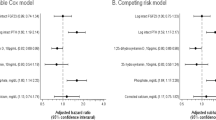Abstract
Transplantation of solid organs including heart, kidney, and liver is associated with rapid bone loss and increased rate of fracture; data on bone marrow transplantation recipients (BMT) are scarce. The purpose of the present study was to examine the magnitude, timing, and mechanism of bone loss following allogeneic BMT, and to study whether bone loss can be prevented by calcium with or without calcitonin. Sixty-nine patients undergoing allogeneic BMT for malignant blood diseases were enrolled into the study. Forty-four (22 women, 22 men) completed 6 months, and 36 patients 1 year follow-up. They were randomized to receive either no additional treatment (n = 22), or oral calcium 1 g twice daily for 12 months (n = 12) or the same dose of calcium plus intranasal calcitonin 400 IU/day for the first month and then 200 IU/day for 11 months (n = 10). Bone mineral density (BMD) at the lumbar spine and three femoral sites (femoral neck, trochanter, Ward’s triangle) was measured by dual-energy X-ray absorptiometry (DXA). Bone turnover rate was followed with markers of bone formation and resorption (serum bone-specific alkaline phosphatase (B-ALP), type I procollagen carboxyterminal (PICP) and aminoterminal propeptide (PINP), serum type I collagen carboxyterminal telopeptide (ICTP)). Serum testosterone was assayed in men. Calcium with or without calcitonin had no effect on bone loss or bone markers; consequently the three study groups were combined. During the first 6 post-transplant months BMD decreased by 5.7% in the lumbar spine and by 6.9% to 8.7% in the three femoral sites (P < 0.0001 for all); no significant further decline occured between 6 and 12 months. four out of 25 assessable patients experienced vertebral compression fractures. markers of bone formation reduced: b-alp by 20% at 3 weeks (P = 0.027), PICP by 40% (P < 0.0001) and pinp by 63% at 6 weeks (P < 0.0001), with a return to baseline by 6 months. the marker of bone resorption, serum ictp was above normal throughout the whole observation period, with a peak at 6 weeks (77% above baseline, P < 0.0001). in male patients serum testosterone decreased reaching a nadir (57% below baseline) at 6 weeks (P = 0.0003). In conclusion, significant bone loss occurs after BMT. It results from imbalance between reduced bone formation and increased bone resorption; hypogonadism may be a contributing factor in men. Bone loss can not be prevented by calcium with or without calcitonin.
This is a preview of subscription content, access via your institution
Access options
Subscribe to this journal
Receive 12 print issues and online access
$259.00 per year
only $21.58 per issue
Buy this article
- Purchase on Springer Link
- Instant access to full article PDF
Prices may be subject to local taxes which are calculated during checkout
Similar content being viewed by others
Author information
Authors and Affiliations
Rights and permissions
About this article
Cite this article
Välimäki, M., Kinnunen, K., Volin, L. et al. A prospective study of bone loss and turnover after allogeneic bone marrow transplantation: effect of calcium supplementation with or without calcitonin. Bone Marrow Transplant 23, 355–361 (1999). https://doi.org/10.1038/sj.bmt.1701586
Received:
Accepted:
Published:
Issue Date:
DOI: https://doi.org/10.1038/sj.bmt.1701586
Keywords
This article is cited by
-
To D or not to D: vitamin D in hematopoietic cell transplantation
Bone Marrow Transplantation (2020)
-
Bone management in hematologic stem cell transplant recipients
Osteoporosis International (2018)
-
Prevention and treatment of bone loss and fractures in patients undergoing a hematopoietic stem cell transplant: a systematic review and meta-analysis
Bone Marrow Transplantation (2017)
-
Factors influencing the late phase of recovery after bone mineral density loss in allogeneic stem cell transplantation survivors
Bone Marrow Transplantation (2016)


